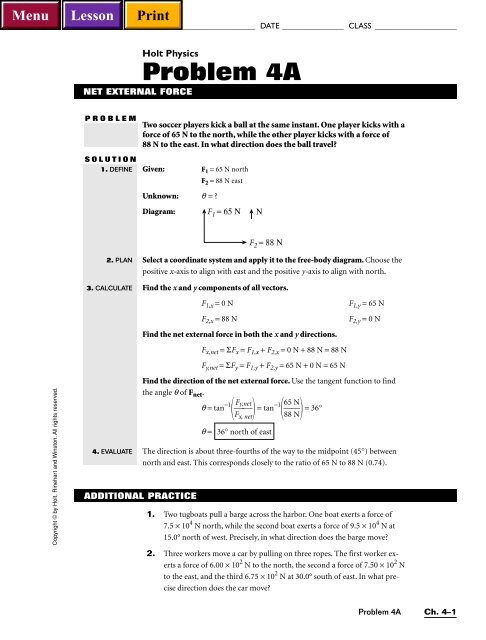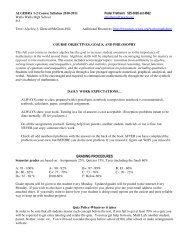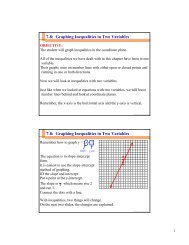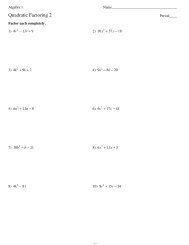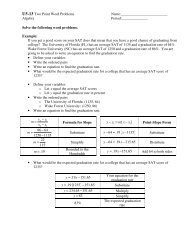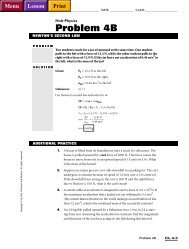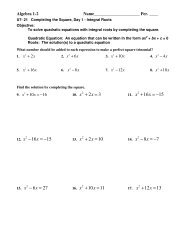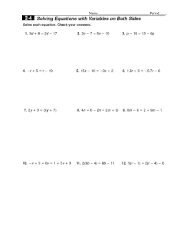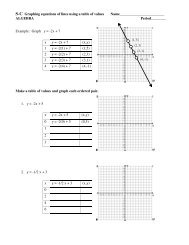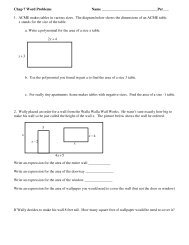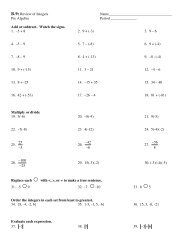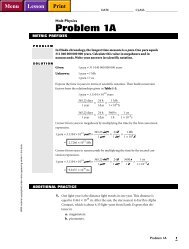Problem 4A - Net External Force
Problem 4A - Net External Force
Problem 4A - Net External Force
- No tags were found...
You also want an ePaper? Increase the reach of your titles
YUMPU automatically turns print PDFs into web optimized ePapers that Google loves.
NAME ______________________________________ DATE _______________ CLASS ____________________3. Four forces are acting on a hot-air balloon: F 1 = 2280.0 N up, F 2 = 2250.0 Ndown, F 3 = 85.0 N west, and F 4 = 12.0 N east. What is the precise directionof the net external force on the balloon?4. What is the magnitude of the largest net force that can be produced by combininga force of 6.0 N and a force of 8.0 N? What is the magnitude of thesmallest such force?5. Two friends grab different sides of a videotape cartridge and pull with forcesof 3.0 N to the east and 4.0 N to the south, respectively. What force would athird friend need to exert on the cartridge in order to balance the other twoforces? What would be that force’s precise direction?6. A four-way tug-of-war has four ropes attached to a metal ring. The forces onthe ring are as follows: F 1 = 4.00 × 10 3 N east, F 2 = 5.00 × 10 3 N north,F 3 = 7.00 × 10 3 N west, and F 4 = 9.00 × 10 3 N south. What is the net force onthe ring? What would be that force’s precise direction?7. A child pulls a toy by exerting a force of 15.0 N on a string that makes anangle of 55.0° with respect to the floor. What are the vertical and horizontalcomponents of the force?8. A shopper pushes a grocery cart by exerting a force on the handle. If theforce equals 76 N at an angle of 40.0° below the horizontal, how much forceis pushing the cart in the forward direction? What is the component of forcepushing the cart against the floor?9. Two paramedics are carrying a person on a stretcher. One paramedic exerts aforce of 350 N at 58° above the horizontal and the other paramedic exerts aforce of 410 N at 43° above the horizontal. What is the magnitude of the netupward force exerted by the paramedics?10. A traffic signal is supported by two cables, each of which makes an angleof 40.0° with the vertical. If each cable can exert a maximum force of7.50 × 10 2 N, what is the largest weight they can support?Copyright © by Holt, Rinehart and Winston. All rights reserved.Ch. 4–2Holt Physics <strong>Problem</strong> Bank
<strong>Force</strong>s and the Laws of MotionChapter<strong>4A</strong>dditional Practice <strong>4A</strong>Givens1. F 1 = 7.5 × 10 4 N northF 2 = 9.5 × 10 4 N at 15.0°north of westq 1 = 90.0°q 2 = 180.0° − 15.0° = 165.0°SolutionsF x,net = F x = F 1 (cos q 1 ) + F 2 (cos q 2 )F x,net = (7.5 × 10 4 N)(cos 90.0°) + (9.5 × 10 4 N)(cos 165.0°)F x,net = −9.2 × 10 4 NF y,net = F y = F 1 (sin q 1 ) + F 2 (sin q 2 )F y,net = (7.5 × 10 4 N)(sin 90.0°) + (9.5 × 10 4 N)(sin 165.0°)F y,net = 7.5 × 10 4 N + 2.5 × 10 4 N = 10.0 × 10 4 NF y,net⎯ Fx,netq = tan −1 = tan−1 =−47°q = 47° north of west10.0 × 10 4 N⎯⎯ −9.2 × 1042. F 1 = 6.00 × 10 2 N northF 2 = 7.50 × 10 2 N eastF 3 = 6.75 × 10 2 N at 30.0°south of eastq 1 = 90.0°q 2 = 0.00°q 3 = −30.0°F x,net = F x = F 1 (cos q 1 ) + F 2 (cos q 2 ) + F 3 (cos q 3 ) = (6.00 × 10 2 N)(cos 90.0°)+ (7.50 × 10 2 N)(cos 0.00°) + (6.75 × 10 2 N)[cos(−30.0°)]F x,net = 7.50 × 10 2 N + 5.85 × 10 2 N = 13.35 × 10 2 NF y,net = F y = F 1 (sin q 1 ) + F 2 (sin q 2 ) + F 3 (sin q 3 ) = (6.00 × 10 2 N)(sin 90.0°)+ (7.50 × 10 2 N)(sin 0.00°) + (6.75 × 10 2 N)[sin (−30.0°)]F y,net = 6.00 × 10 2 N + (−3.38 × 10 2 N) = 2.62 × 10 2 Nq = tan −1 F =2.62 × 10 2 y,netN⎯ tan−1 ⎯⎯Fx,net13.35 × 10 2 Nq =11.1° north of eastCopyright © by Holt, Rinehart and Winston. All rights reserved.3. F 1 = 2280.0 N upwardF 2 = 2250.0 N downwardF 3 = 85.0 N westF 4 = 12.0 N east4. F 1 = 6.0 NF 2 = 8.0 NF y,net = F y = F 1 + F 2 = 2280.0 N + (−2250.0 N) =30.0 NF x,net = F x = F 3 + F 4 = −85.0 N + 12.0 N = −73.0 NF y,net⎯ Fx,net30.0 N⎯−73.0 Nq = tan −1 = tan−1 =−22.3°q = 22.3° up from westF max = F 1 + F 2 = 6.0 N + 8.0 NF max = 14.0 NF min = F 2 − F 1 = 8.0 N − 6.0 NF min = 2.0 NVSection Five—Solution Manual V Ch. 4–1
Givens5. F 1 = 3.0 N eastF 2 = 4.0 N southSolutionsF x,net = F 1 + F 3 (cos q) = 0F 3 (cos q) = −F 1 = −3.0 NF y,net = F 2 + F 3 (sin q) = 0F 3 (sin q) = −F 2 = −(−4.0 N) = 4.0 N√F 3 = [F cosq)] 3 ( + 2 [F si 3 ( n q)] 2 =F 3 =5.0 N√(−3.0 N) 2 + (4.0 N) 2 =√9. 0N 2 + 16N 2 =√25 N 2 F 3 (sin q)⎯ F3 (cos q)q = tan −1 = tan−1 =−53°q = 53° north of west4.0 N⎯−3.0 N6. F 1 = 4.00 × 10 3 N eastF 2 = 5.00 × 10 3 N northF 3 = 7.00 × 10 3 N westF 4 = 9.00 × 10 3 N southF x,net = F 1 + F 3 = 4.00 × 10 3 N + (−7.00 × 10 3 N) = −3.00 × 10 3 NF y,net = F 2 + F 4 = 5.00 × 10 3 N + (−9.00 × 10 3 N) = −4.00 × 10 3 N√√F net = (F x, ne t ) 2 + (F y,n et ) 2 = (−3.00 × 10 3 N) 2 + (−4. 00 × 10 3 N) 2√√F net = 9.00 × 10 6 N 2 + 16. 0× 10 6 N 2 = 25.0 × 10 6 N 2 F net = 5.00 × 10 3 Nq = tan −1 F =−4.00 × 10 3 y,netN⎯ tan−1 ⎯⎯Fx,netq = 53.1° south of west−3.00 × 10 3 N7. F 1 = 15.0 Nq = 55.0°F y = F(sin q) = (15.0 N)(sin 55.0°)F y = 12.3 NF x = F(cos q) = (15.0 N)(cos 55.0°)F x = 8.60 N8. F = 76 Nq = 40.0°9. F 1 = 350 Nq 1 = 58.0°F 2 = 410 Nq 2 = 43°10. F 1 = 7.50 × 10 2 Nq 1 = 40.0°F 2 = 7.50 × 10 2 Nq 2 =−40.0°F x = F(cos q) = (76 N)(cos 40.0°)F x = 58 NF y = F(sin q) = (76 N)(sin 40.0°)F y = 49 NF y,net = F 1 (sin q 1 ) + F 2 (sin q 2 ) = (350 N)(sin 58°) + (410 N)(sin 43)F y,net = 3.0 × 10 2 N + 2.8 × 10 2 NF y,net = 580 NF y,net = F g = F 1 (cos q 1 ) + F 2 (cos q 2 )F y,net = (7.50 × 10 2 N)(cos 40.0°) + (7.50 × 10 2 N) [cos(−40.0°)]F g = 575 N + 575 N = 1.150 × 10 3 NCopyright © by Holt, Rinehart and Winston. All rights reserved.VV Ch. 4–2Holt Physics Solution Manual


